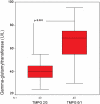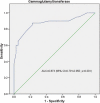High admission levels of γ-glutamyltransferase predict poor myocardial perfusion after primary percutaneous intervention
- PMID: 22012044
- PMCID: PMC3180164
- DOI: 10.1590/s1807-59322011001000010
High admission levels of γ-glutamyltransferase predict poor myocardial perfusion after primary percutaneous intervention
Abstract
Objective: This retrospective study aimed to investigate the relationship between admission levels of serum y-glutamyltransferase and poor myocardial perfusion after primary percutaneous coronary intervention in patients with acute myocardial infarction.
Introduction: Reperfusion injury caused by free radical release and increased oxidative stress is responsible for the pathophysiology of the no-reflow phenomenon in patients with acute myocardial infarction undergoing primary percutaneous coronary intervention. Serum γ-glutamyltransferase is an established marker of increased oxidative stress.
Methods: The study population consisted of 80 patients (64 men and 16 women, mean age = 67.5 + 6.6 years) with thrombolysis in myocardial infarction 0/1 flow pre-procedurally. The patients were divided into two groups according to thrombolysis in myocardial perfusion grades that were assessed immediately following primary percutaneous coronary intervention. The two groups (group 1 and group 2) each consisted of 40 patients with thrombolysis in myocardial perfusion grades 0-1 and thrombolysis in myocardial perfusion grades 2-3, respectively.
Results: Admission pain to balloon time, γ-glutamyltransferase and creatine kinase-MB isoenzyme levels of group 1 patients were significantly higher than those of group 2 patients. Pain to balloon time, γ-glutamyltransferase, peak creatine kinase-MB isoenzyme, low left ventricular ejection fraction and poor pre-procedural thrombolysis in myocardial infarction grade were significantly associated with poor myocardial perfusion by univariate analysis. However, only pain to balloon time and γ-glutamyltransferase levels showed a significant independent association with poor myocardial perfusion by backward logistic regression analysis. Adjusted odds ratios were calculated as 4.92 for pain to balloon time and 1.13 for γ-glutamyltransferase.
Conclusion: High admission γ-glutamyltransferase levels are associated with poor myocardial perfusion in patients with acute myocardial infarction undergoing primary percutaneous coronary intervention, particularly in patients with prolonged pain to balloon time.
Conflict of interest statement
No potential conflict of interest was reported.
Figures
References
-
- King SB, 3rd, Smith SC, Jr, Hirshfeld JW, Jr, Jacobs AK, Morrison DA, Williams DO, et al. 2007 focused update of the ACC/AHA/SCAI 2005 guideline update for percutaneous coronary intervention: a report of the American College of Cardiology/American Heart Association Task Force on Practice guidelines. J Am Coll Cardiol. 2008;51:172–209. 10.1016/j.jacc.2007.10.002 - DOI - PubMed
-
- Gibson CM, Cannon CP, Murphy SA, Ryan KA, Mesley R, Marble SJ, et al. Relationship of TIMI myocardial perfusion grade to mortality after administration of thrombolytic drugs. Circulation. 2000;101:125–30. - PubMed
-
- Ito H, Maruyama A, Iwakura K, Takiuchi S, Masuyama T, Hori M, et al. Clinical implications of the 'no reflow' phenomenon. A predictor of complications and left ventricular remodeling in reperfused anterior wall myocardial infarction. Circulation. 1996;93:223–8. - PubMed
-
- Morishima I, Sone T, Okumura K, Tsuboi H, Kondo J, Mukawa H, et al. Angiographic no-reflow phenomenon as a predictor of adverse long-term outcome in patients treated with percutaneous transluminal coronary angioplasty for first acute myocardial infarction. J Am Coll Cardiol. 2000;36:1202–9. 10.1016/S0735-1097(00)00865-2 - DOI - PubMed
-
- Krefetz RG, McMillin GA.Enzymes Clinical Chemistry. 2005255–256.( Bishop ML FE, Schoeff LE.). Baltimore Lippincott: Williams&Wilkins
MeSH terms
Substances
LinkOut - more resources
Full Text Sources
Medical
Miscellaneous



